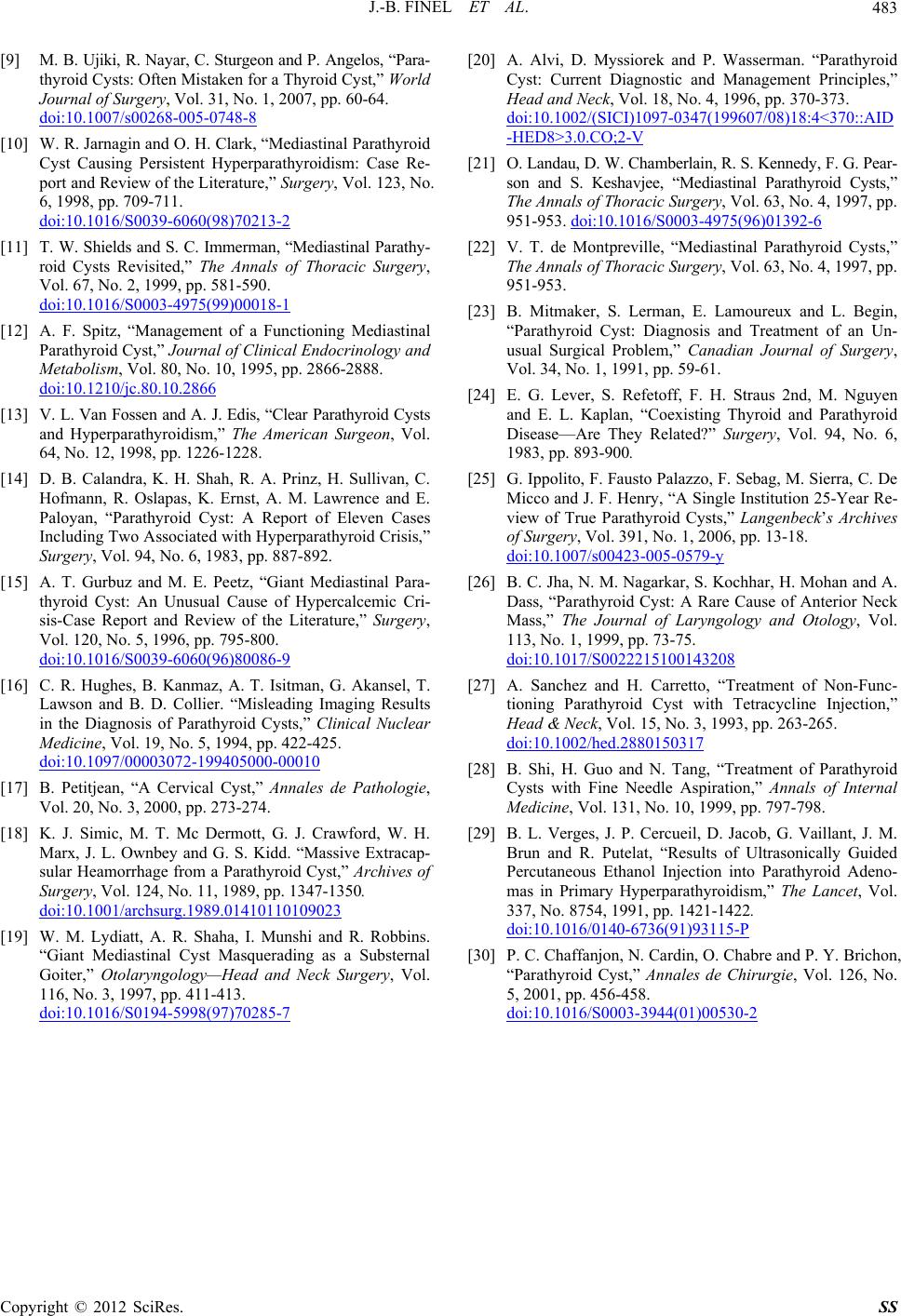
J.-B. FINEL ET AL.
Copyright © 2012 SciRes. SS
483
[9] M. B. Ujiki, R. Nayar, C. Sturge on and P. Angelos, “Para-
thyr oid Cy sts: Of te n Mista ken for a Thyr oid Cy st, ” World
Journal of Surgery, Vol. 31, No. 1, 2007, pp. 60-64.
doi:10.1007/s00268-005-0748-8
[10] W. R. Jarnagin and O. H. Clark, “Mediastinal Parathyroid
Cyst Causing Persistent Hyperparathyroidism: Case Re-
port and Review of the Literature,” Surgery, Vol. 123, No.
6, 1998, pp. 709-711.
doi:10.1016/S0039-6060(98)70213-2
[11] T. W. Shields and S. C. Immerman, “Mediastinal Parathy-
roid Cysts Revisited,” The Annals of Thoracic Surgery,
Vol. 67, No. 2, 1999, pp. 581-590.
doi:10.1016/S0003-4975(99)00018-1
[12] A. F. Spitz, “Management of a Functioning Mediastinal
Parathyroid Cyst,” Journal of Clinical Endocrinology and
Metabolism, Vol. 80, No. 10, 1995, pp. 2866-2888.
doi:10.1210/jc.80.10.2866
[13] V. L. Van Fossen and A. J. Edis, “Clear Parathyroid Cysts
and Hyperparathyroidism,” The American Surgeon, Vol.
64, No. 12, 1998, pp. 1226-1228.
[14] D. B. Calandra, K. H. Shah, R. A. Prinz, H. Sullivan, C.
Hofmann, R. Oslapas, K. Ernst, A. M. Lawrence and E.
Paloyan, “Parathyroid Cyst: A Report of Eleven Cases
Including Two Associated with Hyperparathyroid Crisis,”
Surgery, Vol. 94, No. 6, 1983, pp. 887-892.
[15] A. T. Gurbuz and M. E. Peetz, “Giant Mediastinal Para-
thyroid Cyst: An Unusual Cause of Hypercalcemic Cri-
sis-Case Report and Review of the Literature,” Surgery,
Vol. 120, No. 5, 1996, pp. 795-800.
doi:10.1016/S0039-6060(96)80086-9
[16] C. R. Hughes, B. Kanmaz, A. T. Isitman, G. Akansel, T.
Lawson and B. D. Collier. “Misleading Imaging Results
in the Diagnosis of Parathyroid Cysts,” Clinical Nuclear
Medicine, Vol. 19, No. 5, 1994, pp. 422-425.
doi:10.1097/00003072-199405000-00010
[17] B. Petitjean, “A Cervical Cyst,” Annales de Pathologie,
Vol. 20, No. 3, 2000, pp. 273-274.
[18] K. J. Simic, M. T. Mc Dermott, G. J. Crawford, W. H.
Marx, J. L. Ownbey and G. S. Kidd. “Massive Extracap-
sular Heamorrhage from a Parathyroid Cyst,” Archives of
Surgery, Vol. 124, No. 11, 1989, pp. 1347-1350.
doi:10.1001/archsurg.1989.01410110109023
[19] W. M. Lydiatt, A. R. Shaha, I. Munshi and R. Robbins.
“Giant Mediastinal Cyst Masquerading as a Substernal
Goiter,” Otolaryngology—Head and Neck Surgery, Vol.
116, No. 3, 1997, pp. 411-413.
doi:10.1016/S0194-5998(97)70285-7
[20] A. Alvi, D. Myssiorek and P. Wasserman. “Parathyroid
Cyst: Current Diagnostic and Management Principles,”
Head and Neck, Vol. 18, No. 4, 1996, pp. 370-373.
doi:10.1002/(SICI)1097-0347(199607/08)18:4<370::AID
-HED8>3.0.CO;2-V
[21] O. Landau, D. W. Chamberlain, R. S. Kennedy, F. G. Pear-
son and S. Keshavjee, “Mediastinal Parathyroid Cysts,”
The Annals of Thoracic Surgery, Vol. 63, No. 4, 1997, pp.
951-953. doi:10.1016/S0003-4975(96)01392-6
[22] V. T. de Montpreville, “Mediastinal Parathyroid Cysts,”
The Annals of Thoracic Surgery, Vol. 63, No. 4, 1997, pp.
951-953.
[23] B. Mitmaker, S. Lerman, E. Lamoureux and L. Begin,
“Parathyroid Cyst: Diagnosis and Treatment of an Un-
usual Surgical Problem,” Canadian Journal of Surgery,
Vol. 34, No. 1, 1991, pp. 59-61.
[24] E. G. Lever, S. Refetoff, F. H. Straus 2nd, M. Nguyen
and E. L. Kaplan, “Coexisting Thyroid and Parathyroid
Disease—Are They Related?” Surgery, Vol. 94, No. 6,
1983, pp. 893-900.
[25] G. Ippolito, F. Fausto Palazzo, F. Sebag, M. Sierra, C. De
Micco and J. F. Henry, “A Single Institution 25-Year Re-
view of True Parathyroid Cysts,” Langenbeck’s Archives
of Surgery, Vol. 391, No. 1, 2006, pp. 13-18.
doi:10.1007/s00423-005-0579-y
[26] B. C. Jha, N. M. Nagarkar, S. Kochhar, H. Mohan and A.
Dass, “Parathyroid Cyst: A Rare Cause of Anterior Neck
Mass,” The Journal of Laryngology and Otology, Vol.
113, No. 1, 1999, pp. 73-75.
doi:10.1017/S0022215100143208
[27] A. Sanchez and H. Carretto, “Treatment of Non-Func-
tioning Parathyroid Cyst with Tetracycline Injection,”
Head & Neck, Vol. 15, No. 3, 1993, pp. 263-265.
doi:10.1002/hed.2880150317
[28] B. Shi, H. Guo and N. Tang, “Treatment of Parathyroid
Cysts with Fine Needle Aspiration,” Annals of Internal
Medicine, Vol. 131, No. 10, 1999, pp. 797-798.
[29] B. L. Verges, J. P. Cercueil, D. Jacob, G. Vaillant, J. M.
Brun and R. Putelat, “Results of Ultrasonically Guided
Percutaneous Ethanol Injection into Parathyroid Adeno-
mas in Primary Hyperparathyroidism,” The Lancet, Vol.
337, No. 8754, 1991, pp. 1421-1422.
doi:10.1016/0140-6736(91)93115-P
[30] P. C. Chaffanjon, N. Cardin, O. Chabre and P. Y. Brichon,
“Parathyroid Cyst,” Annales de Chirurgie, Vol. 126, No.
5, 2001, pp. 456-458.
doi:10.1016/S0003-3944(01)00530-2